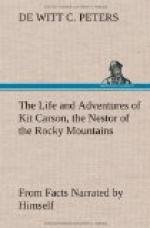and, so snugly are they made to fit every available
part of the animal, that it seems almost impossible
for cold to touch them. Corn and fodder, to a
limited extent, is transported; but, even with these
precautions, the mules now and then succumb to cold.
The man covers his body with warm clothing and carries
with him furs and robes enough to be seemingly able
to defy the storms. He can provide himself only
with a scanty amount of fuel, for his means of conveyance
are very contracted. When overtaken by the storms,
which may last several days, he is rendered almost
powerless, and is at the tender mercies of the gale;
for he cannot make fires,—and without them
he may perish. This is not true of every trip
made across the plains during the winter, for, like
on the ocean, the passage may be frequently gone through
with the encountering of but little real suffering.
One thing in favor of making the journey in this season
of the year is, the probability of not seeing an Indian.
They, usually, during the cold months, stow themselves
away in their, comparatively speaking, warm mountain
retreats. In crossing the plains, small parties
find the item of meeting Indians to be of considerable
importance, as, even in the time of peace, they are
very exacting and troublesome, demanding that provisions
should be given them, by way of toll. To refuse
is apt to bring down their ire, when they will usually
help themselves to whatever suits their fancy.
They are very partial to sugar, which, when they cannot
say the word in English, they call “Shoog.”
If not understood, they make their wants known by
the Indian sign of touching with the index finger
the tip of the tongue, thereby indicating the sweetness
of the article. Many of them come armed with a
piece of paper, which testimonial of good behavior
they have obtained from their agent or forced from
some traveler. As they cannot read, it makes
but little difference what is the sense of the writing
so long as it is bona fide penmanship.
I once saw one of these documents which the owner
prized very highly, but, had he known the purport of
his paper, he would have sighed for the scalp of his
kind friend who wrote it. The language
was as follows: “Crossing of the Arkansas,”
etc. “The bearer, Young Antelope,
is a good Indian and will not take anything out of
his reach. This is to warn traders and travelers
to beware of his race, breed, seed, and generation.”
It was signed evidently with a fictitious name, and
answered the purpose for which it was intended, which
was, to get rid of an ugly customer and to put strangers
on their guard against the man who carried it.
On arriving at Taos, Kit Carson left this party and proceeded to Rayado, where he was, soon after, actively engaged in farming pursuits.




